Abstract
Bioclimate alteration unquestionably poses a current but also a potential future threat to natural and agricultural ecosystems and their services. In this scope, the present and future bioclimatic footprint of the Central European territory is investigated and presented. For the first time, an ultrahigh spatial resolution (<250 m) of the de Martonne index is analyzed over the entire area, as well as for individual countries (Austria, Switzerland, Czech Republic, Hungary and Slovakia). The research is performed for the reference period (1981–2010) and for three time series (2011–2040; 2041–2070; 2071–2100) under two emissions scenarios (SSP370 and SSP585) for the determination of the potential short-term and distant future bioclimatic change trends. Projection results reveal higher xerothermic trends over the lowland agricultural areas mostly in 2071–2100 and under the extreme SSP585, with the classes’ spatial distributions going from 0.0% to 2.3% for the semi-dry class and from 0.0% to 30.1% for the presiding Mediterranean class. Additionally, more than half of the territory’s agricultural surface area (53.4%) is foreseen to be depending on supplementary irrigation by 2100. Overall, more intense dry thermal conditions are expected to impact the agricultural areas of the Czech Republic, Slovakia and Hungary with the latter emerging as particularly vulnerable.
1. Introduction
Ecosystems and landscapes, both cultural and natural, are precious assets that safeguard the quality of life; however, the impact of climate change (CC) on biodiversity, ecosystem condition and nature’s contribution to people could become one of the major drivers over the coming years, with observed trends in natural resources exploitation, pollution, and impact from invasive species leading to a significant decline of ecosystems and their services, a trend that will likely continue to pose major challenges combined with future climate change conditions [1].
In the concept of CC, extensive scientific research has been focused on the alterations of the bioclimate and the consequent impacts of the bioclimatic change on the earth’s biosphere [2,3,4,5,6,7,8].
The central part of Europe (CEu) shapes a vast sub-continental territory and comprises six countries located in central Europe (ordered alphabetically by their ISO country codes as AT: Austria, CH: Switzerland, CZ: Czech Republic, HU: Hungary and SK: Slovakia) already demonstrates high climatic changes, the evolution of which is expected to keep on pressurizing its abundant natural and anthropogenic ecosystems in the future [8,9,10]. A continuous warming and drying trend has been recorded in various areas of CEu (e.g., a surface temperature rise of 0.8 °C and a precipitation decrease of 60–80 mm in the Carpathian Basin) [11]. Both the maximum and minimum temperatures have increased over the 20th century, with a more significant summer warming manifested in the first half of the century [12]. Increases in long-term drought occurrence have been reported in CEu (e.g., increased dryness trend across Austria, Czech Republic, Hungary and Slovakia) as driven by the increased evaporation demand towards the end of the 20th century and in the early 21st century [13,14].
Projections on CEu’s climatic evolution depict future intense temperature warming. Simulation results indicate a temperature increase of 1.4–2.6 °C in summer by the mid-century and of over 4 °C by the end of the century. In Hungary [15], an average temperature rise between 0.12 °C and 3.76 °C in Switzerland [16], a further increase of less than 2 °C to 4 °C in Austria until the year 2100 [17], an increase in the monthly and annual temperatures by 1.5 °C to 4.7 °C in Slovakia [18] and a 2.7 °C summer temperature rise by 2070, in the Czech Republic [19]. Projection results also suggest remarkable drying due to the temperature increase and precipitation decrease and especially in the summer months [20,21] (e.g., reduction in average summer precipitation by 5–10% and over 20%, respectively, by the mid-century and end of the century in Hungary; total precipitation decrease by 33% in summer, in Slovakia) [15,18], except for precipitation increases foreseen mostly during wintertime (e.g., precipitation increase between 48.1 mm and 398.7 mm by the end of the century in Switzerland [16], of approximately 30% in northeastern Austria [17] and from 20% to 56%, in Slovakia) [18]. Some of these facts, which are indicative of future drying, underline the possible acceleration of the drought risk (e.g., in the Czech Republic) [22] and desertification risk (e.g., in central Hungary) with the contribution of the frequency and amplitude of extreme weather events [23].
The warmer and drier conditions formed due to CC over CEu, have resulted in intensified weather extremes described mainly by the increasing trend in drought occurrences (e.g., in Slovakia) [24] and more robust and prolonged drought episodes (e.g., more pronounced drought waves in Hungary with a trend of 1.4% per decade and more intensified and long-lasting dry events during the second half of the 21st century) [25,26]. Heatwave events have become more frequent, longer, severe and intense, while cold wave events demonstrate decreasing duration, severity, intensity [27] and occurrence [28]. Large quantities of intense precipitation are demonstrated to occur in the future, and the number of frost days is expected to be reduced, while summer days and heatwave days will be significantly increased (e.g., adding up to a monthly duration by the end of the century in Hungary) [15].
The up-to-present and future impacts of the bioclimatic change on the CEU’s agricultural sector may involve negative effects on crop yields (yield depression and reduced yield stability) owing to drought severity and the increased frequency of extremely high-temperature values [29,30,31,32], product quality decline [33], prolonged periods of water scarcity [34] and higher crop evapotranspiration [35]. Other impacts of the altered bioclimate refer to lower water recharge rates and groundwater table [36], decreasing soil moisture content [37], modifications of the physicochemical and biological properties of soils [38], soil erosion and topsoil loss [39]. Study results also include the increased occurrence and favoring of crop insect pest species and insect infestations [40] and the expansion of invasive species and increase in generations which may induce extended crop damage [41]. The impacts of CC in the CEu also refer to phenology advancements and earlier harvesting [10,42], changes in the crops’ growing season period duration [10,43], significant shifts in the agroclimatic zones [10,44], alterations to the land area suitable for individual crop production (e.g., a substantial increase in the total area exploited for viticultural production and grain maize) [10,45] and the dependence of crop production on irrigation [46].
The already recorded and future potential impacts of the altered bioclimate on the investigated territory’s natural areas encompass forest cover change and forest line shifts [47], increased risk of tree windthrow and short-term loss of timber [48], effects on tree species composition and carbon sequestration [48,49]. Reports may also include changes in plant diversity [50], vegetation cover and microbial biomass [51], limited tree growth and the decline in forest productivity [52]. Scientific research extensively outlines phenology (e.g., flowering) advancement [53], high risk for forest fires, forest insect outbreaks and shifts of outbreak epicenters [54,55], drought-induced tree vitality decline [56], increased mortality rates [57], soil erosion, landslides, higher desertification sensitivity [58], decreased biomass production [59], lengthening of the growing season [60] and the migration of vegetation zones [61].
The bioclimatic approach to the effects of CC is achieved by the application of numerical indicators known as bioclimatic indices in an overall effort to better understand the decisive synchronous role of altered atmospheric parameters [62]. Among several indices, this is mathematically demonstrated by the simple de Martonne Aridity Index (IDM), which combines air temperature and precipitation recorded data, and the resulting values reliably assess the dryness status of an area [63]. This assessment is performed by classifying the investigated area’s bioclimate into seven categories described as “dry” to “extremely humid” [63].
Although a practically old bioclimatic index, the IDM is commonly and most recently applied in scientific research [7] owing to its effectiveness and even, in some cases, distinction as a better indicator of the climate’s dryness degree [62,64], proving its broad incorporation in the sciences of, e.g., Climatology [65,66,67], Bioclimatology/Biometeorology [68,69], Ecology [70,71] and in surveys on agricultural issues [72,73].
For the area in consideration, dryer climatic conditions have been projected by Bartholy et al. [21] for Hungary by 2070–2100 compared to the reference period (1961–1990). The implementation of a 25 km horizontal resolution under three emission scenarios (A2, A1B, and B2) has resulted in the foreseen significant warmer and drier regime, especially during the summer period. By assuming the A1B emission scenario and applying a similar climatic data resolution (approximately 25 km), Blanka et al. [74] have suggested that the frequency and duration of the drought periods will increase over the entire country by 2100, mostly in the Great Hungarian Plain, with serious impacts on the agricultural sector. Ladányi et al. [75] have projected changes in the IDM for the 2021–2050 and 2071–2100 time periods based on regional climate models utilizing the A1B scenario. They demonstrated increasing drought hazards over the Kiskunság National Park (south Hungary) and its surrounding landscapes, with the latter in the northern part of the territory being relatively more exposed by the end of the 21st century. Gavrilov et al. [76], who examined the Central and Southern Pannonian Basins’ annual aridity trend, demonstrated no changes for Hungary during the investigated period (1949–2017). Nistor [77] has performed a projection survey over the entire southeastern European territory for the 2011–2040 and the 2041–2070 future time periods by adopting an RCP of 4.5. Significant effects of CC on the groundwater resources were demonstrated, among other countries, for the eastern part of Austria and Hungary owing to the higher xerothermic trends as estimated by the IDM at a spatial resolution of 1 km2. Cheval et al. [78] have also demonstrated more xerothermic bioclimatic characteristics anticipated under the A1B scenario for Austria, Hungary, Slovakia and Switzerland where higher spatial distributions of the more arid IDM classes analyzed at a 25 km spatial resolution are expected by the year 2050.
From the aforementioned documentation, it is apparent that projection outcomes concerning the future bioclimatic footprint of CEu, as a result of the application of the IDM, are relatively limited. Additionally, the employed emissions scenarios are characterized by rather small variability (e.g., A2, A1B, B2 and RCP of 4.5), and the adopted spatial resolution of the climatic data is rather coarse (e.g., 1 km and 25 km).
The CEu constitutes a climatically diverse territory, the landscape of which is defined by agricultural and natural areas of paramount societal and economic significance, constituting representative ecosystems of unique ecological and cultural importance. By also considering the growing issue of the future CC effects in the CEu, it was regarded as fundamental to investigate the future bioclimatic conditions over the territory’s and individual countries’ agricultural and natural areas based on calculations performed by a reliable index such as the IDM. For this purpose, the distribution of the IDM’s bioclimatic classes is investigated for the reference period (Ref: 1981–2010) and three time periods (P1: 2011–2040; P2: 2041–2070; P3: 2071–2100). The index is computed at the horizontal ultrahigh-resolution analysis of less than 250 m under the two emissions scenarios (SSP370 and SSP585). Comparisons between the present and the future bioclimate profiles aim for the identification of the short-term and distant future trends of the territory’s bioclimatic change.
The innovative features of the present investigation involve the implementation of a horizontal ultrahigh-resolution analysis of the IDM (of less than 250 m) over an extensive area consisting of six countries of central Europe for the assessment of the whole territory’s, but also of each individual country’s bioclimatic evolution, through illustrations of the current and future bioclimatic status. A series of maps displaying the IDM classes’ spatial distribution over the entire domain, accompanied by related spatial statistics focused on each country’s natural and agricultural areas, are presented.
The demonstrated outcomes of the present study may serve as a useful and efficient scientific information source for the proactive management and prevention of the upcoming future impacts of CC on the CEu’s agricultural sector and natural formations, i.e., to support scientifically based decision and policy making for rural and natural areas.
2. Materials and Methods
2.1. Study Area
The land cover features of the entire study area are illustrated in Figure 1. The Czech (CZ) Republic is a hilly plateau almost entirely surrounded by mountain ranges. Slovakia (SK) is characterized by its vast mountainous topography occupied by the Tatra, Fatra and Ore Mountains. The country’s fertile lowland terrain expands to the west along the Danube River Plain, to the south, and over the eastern Slovak Flat area. Hungary (HU) is mainly a flat country dominated by the significant agricultural zones of the Great Hungarian Plain, the Little Hungarian Plain, and the Transdanubia region in western HU. The landscape of Austria (AT) is broadly mountainous, dominated by high Alpine Mountain chains. Agricultural development is located in the eastern and southeastern Lowlands (e.g., Burgenland, Steiermark, Kärnten, and Niederösterreich), where the country becomes less alpine. In Switzerland (CH), agricultural practice dominates the Swiss Plateau, which extends east to west between the Jura Mountains and the Swiss Alps.
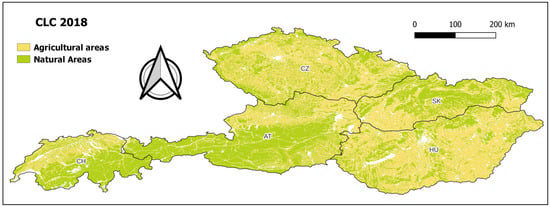
Figure 1.
The generalized Corine Land Cover 2018 (CLC 2018) illustrating the studied area’s (territory’s) natural and agricultural areas (AT = Austria, CH = Switzerland, CZ = Czech Republic, HU = Hungary, SK = Slovakia).
2.2. Data and Methods
Data and Analysis Methods
The CHELSA repository [79,80] is a widely recorded database extensively applied and used by researchers [81,82,83,84]. This database contains multiple atmospheric indices and indicators accompanied by fundamental atmospheric parameters, including air temperature and precipitation in a spatial resolution of 30 arcsecs (~1 km). The CHELSA data corresponding to a period between 1979 and 2100 was accomplished from reanalysis and bioclimate change projection approaches. The CHELSA atmospheric data downscaling to a resolution of less than 250 m (the typical resolution is 238.09 m for 0.0025 degrees) was performed by the regression process via the spatialEco [85] together with the Tidyverse [86] and the Terra [87] R packages. The air temperature data have been downscaled by utilizing altitude and latitude parameters accompanied by the Euclidean distance from the shoreline. This allows very high reliability when the precipitation data have been resampled to the desired resolution via the bilinear method. Raster algebra methods have performed the IDM assessment for the time periods under the adopted scenarios.
Overall, the widely used De Martonne bioclimatic index was computed using a raster method with an ultra-high geographical resolution for four climatic time periods. Two greenhouse gas (GHG) emission scenarios were also considered. The SSP370 and SSP585 emissions scenarios, which correspond to the RCP7 and RCP8.5, respectively, are included (Figure 2). Future increases in GHG concentrations are represented by the scenarios chosen. While the SSP370 is used to examine the failure to take early and significant action to reduce GHG emissions, the SSP585 is the extreme scenario with the worst effects [88,89,90,91,92,93,94]. The time frames are 1981–2010 as the reference period (Ref) and 2011–2040 (P1), 2041–2070 (P2), and 2071–2100 (P3) as future periods.

Figure 2.
The combinations matrix of the SSP and RCP scenarios. Synthesis of Rogelj et al. [95], Meinshausen et al. [96] and O’Neill et al. [97].
In the present study, the bioclimatic index of De Martonne (IDM) was calculated with an annual time step based on the application of the average precipitation (P) and temperature (T) values as defined by the formula [63,98]:
where:
P: is the annual precipitation (mm)
T: is the annual average air temperature (°C)
In contrast to the dry bioclimatic conditions specified by the lower values of the IDM, the humid bioclimatic conditions are specified by the higher values of the IDM. Additionally, the index can be calculated on more frequent timescales, such as seasonal and/or monthly. The classification scheme in Table 1 displays the bioclimate types according to the IDM values. There are seven different bioclimate classifications, ranging from arid or dry to excessively humid, representing the various amounts of irrigation needs [7,99].

Table 1.
The De Martonne Index (IDM) categorization, according to Passarella et al. [63].
The commonly applied CORINE Land Cover (CLC) dataset [100] was used to distinguish the investigated territory’s agricultural and natural areas. For this purpose, the 2.1, 2.2, 2.3, and 2.4 CLC classes were considered as agricultural areas and the 3.1, 3.2, and 3.3 classes as natural areas. The accuracy of the CLC exceeds 100 m, corresponding to relatively high thematic accuracy (≥85%) in the most recent year (2018).
The exploitation of the available land cover features and country border polygons allowed the performance of spatial statistical analysis for constructing comprehensive plots and maps to detect the bioclimatic qualitative and quantitative evolution over the CEu. The conducted analysis scheme is illustrated in the flowchart of Figure 3.
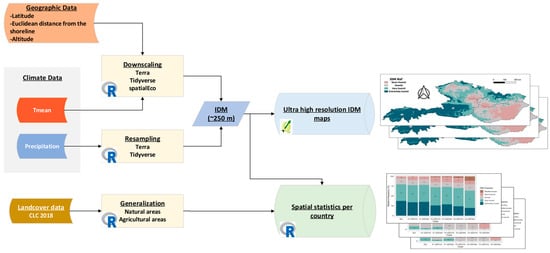
Figure 3.
The performed analysis process.
3. Results and Discussion
3.1. Spatial Patterns of the De Martonne Index
As illustrated in Figure 4, the CEu’s bioclimate at the reference period (1981–2010) is spatially distributed among 4 de Martonne bioclimatic categories defined as semi-humid, humid, very humid, and extremely humid. Also, some black spots in the southwestern part of Switzerland indicate the not applicable areas as an outcome of average temperature below the threshold of −10 °C. The more humid bioclimatic conditions represented by the very humid and extremely humid classes characterize the higher altitudinal terrain (e.g., Alpine Mountain chains of CH and AT and mountainous topography of CZ, SK, and HU) where the latter class appears as clearly dominative in the western part of the CEu (in CH and AT). The areas denoted as humid and semi-humid result in lower altitudes. They constituted mostly lowland agricultural inland parts of the CEu (e.g., the Czech Republic Moravian and Central Bohemian areas, the Slovakian and Austrian Danubian lowland and the Great Hungarian Plain).
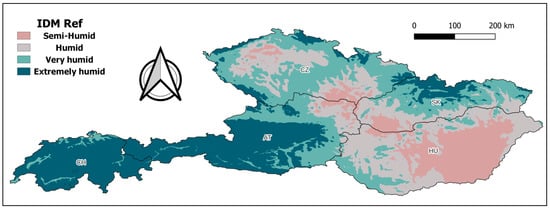
Figure 4.
The de Martonne classes’ spatial distribution at the reference (Ref) period: 1981–2010 (AT = Austria, CH = Switzerland, CZ = Czech Republic, HU = Hungary, SK = Slovakia).
Results for the 1st time period (2011–2040) under the SSP370 scenario (Figure 5A) overall reveal minor differentiations of the CEu’s bioclimatic regime in relation to the reference period (Figure 4). However, a slight trend towards more xerothermic conditions is demonstrated for the southeastern part of the CEu, where the Mediterranean conditions are expected to characterize part of the Great Hungarian Plain at the expense of the semi-humid regime. This tendency is spatiotemporally developed under the SSP370 scenario as illustrated for the 2nd time period (2041–2070) and for the long-term time frame (2071–2100) (Figure 5B and Figure 5C, respectively). A gradual expansion of the Mediterranean, semi-humid and humid areas is foreseen over the right half of the investigated territory. As depicted, substantial parts (mainly lowland agricultural areas) of CZ, SK and mostly of HU will be subjected to warmer and drier conditions by 2100, with the latter expected to be almost entirely influenced by the Mediterranean regime (Figure 5C). Furthermore, more dry thermal conditions are projected predominately over the western CEu, as evidenced by the progressive reduction in the extremely humid agricultural areas in favor of the very humid areas in northern CH (Figure 5C vs. Figure 5A,B).
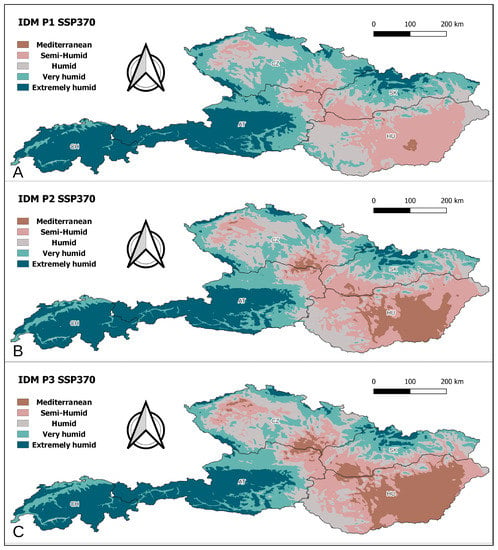
Figure 5.
The de Martonne classes’ spatial distribution; (A): P1 period (2011–2040); (B): P2 period (2041–2070); (C): P3 period (2071–2100) under the SSP370 scenario (AT = Austria, CH = Switzerland, CZ = Czech Republic, HU = Hungary, SK = Slovakia).
The employed more extreme SSP585 scenario appears in general as more impactful on the xerothermic evolution of CEu’s bioclimatic footprint (Figure 6). Results exhibit the same five bioclimatic classes (Mediterranean to extremely humid) as in all investigated periods of the SSP370 scenario (Figure 5). Still, the drier semi-humid and mainly Mediterranean conditions are projected to influence more extensive areas of the northern, central and southeastern CEu. Regarding the third period of the SSP370 scenario (Figure 5C), it is highlighted that an additional drier De Martone class corresponding to the semi-dry environment is expected to characterize a substantial agricultural area of the southern Great Hungarian Plain by 2100 under the SSP585 scenario (Figure 6C).
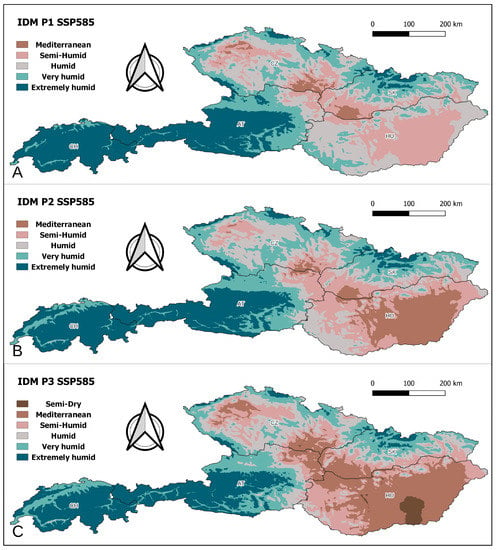
Figure 6.
The de Martonne classes’ spatial distribution; (A): P1 period (2011–2040); (B): P2 period (2041–2070); (C): P3 period (2071–2100) under the SSP585 scenario (AT = Austria, CH = Switzerland, CZ = Czech Republic, HU = Hungary, SK = Slovakia).
3.2. The De Martonne Index Spatial Statistics
Figure 7, Figure 8, Figure 9, Figure 10 and Figure 11 display the relative frequencies of de Martonne’s bioclimatic classes distributed over the agricultural and natural areas of CEus’ individually investigated countries (Austria, Switzerland, Czech Republic, Hungary and Slovakia) and Figure 12 over the entire examined area. In order to achieve a more comprehensive description of the results, designations were employed; the reference period as Ref, the examined cases of the first, second, and third time periods under the SSP370 scenario as P1 SSP370, P2 SSP370, and P3 SSP370, respectively, and under the extreme SSP585 scenario as P1 SSP585, P2 SSP585, and P3 SSP585.
3.2.1. Austria (AT)
According to the results displayed in Figure 7A, it becomes evident that in relation to the Ref, a decreasing trend of AT’s agricultural areas falling within the very humid and extremely humid bioclimate categories is foreseen along with the concomitant spatial increase of the semi-humid areas up to P2 SSP370 (from 5.8% to 13.1%) and the Mediterranean areas up to P3 of both scenarios. Overall, the xerothermic trend is more evident for P3 SSP585, given the resulting higher distribution of the Mediterranean class (11.4% vs. 3.7% in P3 SSP370). Furthermore, in this case, approximately one-fifth of the AT’s agricultural surface area will depend on supplementary irrigation owing to a total semi-humid and Mediterranean classes distribution of 20.5%.
A continuous reduction in the natural areas with extremely humid conditions is projected under both emission scenarios, as illustrated in Figure 7B. The highest frequency reduction in the extremely humid class is demonstrated at the P3 of both scenarios, with the SSP585 being slightly more influential (60.1% vs. 63.8% in P2 SSP370 and 74.2% in Ref). The slight change towards warmer and drier conditions is denoted by the projected gradual increases in all the drier categories and mostly by the highest frequency of the Mediterranean and semi-humid class in P3 SSP585.
Nistor [79] has performed a projection survey over the entire southeastern European territory (involving countries along the western coast from AT to Albania) for the 2011–2040 (respective P1 of the present study) and the 2041–2070 (respective P2) time periods under a more optimistic RCP of 4.5. As estimated by the de Martonne index at a lower spatial resolution of 1 km2, significant impacts of CC were illustrated over eastern AT. More precisely, classifications fell within 5 categories (from Mediterranean to Extremely humid) as in the present study for both area categories. Furthermore, according to Nistor [79], a slight expansion of the areas influenced by the drier Mediterranean at the expense of the semi-humid bioclimate was projected for northeastern AT in the 2041–2070 time period (coinciding with the agricultural areas of the present study at P2, as shown in Figure 7A).
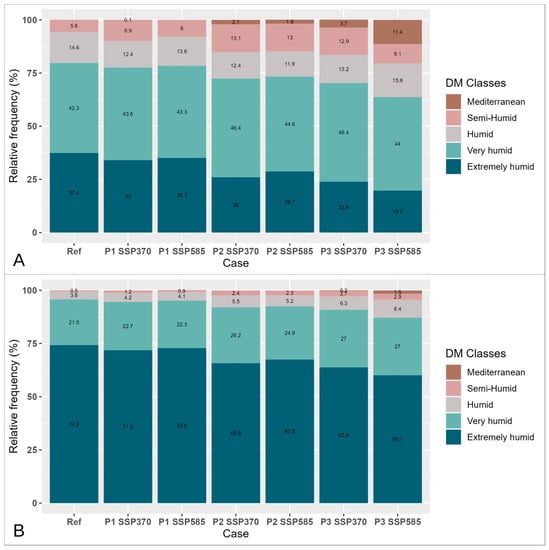
Figure 7.
The de Martonne classes’ spatial relative frequency over the agricultural (A) and natural areas (B) of Austria.
3.2.2. Switzerland (CH)
As shown in Figure 8A, the characterization of CH’s bioclimatic regime over the agricultural areas is mostly distributed among the very humid and extremely humid classes, with the latter exhibiting the highest relative frequencies. The apparent effect of the warmer and drier bioclimatic conditions in all periods of both scenarios is underlined by the gradual expansion of the agricultural areas influenced by the very humid conditions. The increased relative frequency of the very humid class at the expense of the extremely humid is more pronounced in P3 SSP585 (36.6% vs. 34% in P3 SSP370 and 12.1% in Ref). By 2100, more cropping areas will be in need of infrequent irrigation given the tripling of the very humid class’s distribution in relation to the Ref (36.6% vs. 12.1% in Ref).
The extremely humid conditions dominate most natural CH areas, as shown in Figure 8B. By comparison with the Ref, the more dry-thermal transformation of the areas’ bioclimate is foreseen to take place in the future under both scenarios, with a slightly higher reduction in the extremely humid natural areas expected to take place in P3 SSP585 (62.7% vs. 65.4% in P3 SSP370 and 87.9% in Ref). It is noted that the natural areas of CH characterized by a temperature value lower than −10 °C render the application of the IDM impossible (“Not applicable” in Figure 8B).
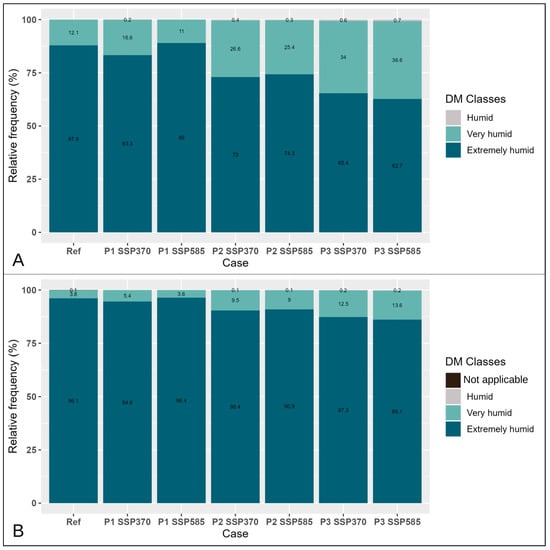
Figure 8.
The de Martonne classes’ spatial relative frequency over the agricultural (A) and natural areas (B) of Switzerland.
3.2.3. Czech Republic (CZ)
The overall warming and drying of CZ’s agricultural areas are shown in Figure 9A, where the decreasing frequencies of the very humid and extremely humid classes by 2100 are demonstrated under both scenarios. Higher xerothermic trends, however, result for P3 SSP585, at which an additional drier semi-dry category (0.1%) is estimated, and the highest relative frequencies of the Mediterranean (12.6% vs. 5.7% in P3 SSP370 and 0.0% in Ref) and semi-humid classes (25.9% vs. 18.9% in P3 SSP370 and 7.9% in Ref) are projected. The increased xerothermic trend projected for P3 SSP585, mainly due to the significant expansion of the agricultural areas with Mediterranean and semi-humid bioclimatic characteristics (38.5% in total), calls attention to the potential supplementary irrigation requirements of CZ’s future crop systems.
The natural areas of CZ are expected to be influenced by warmer and drier bioclimatic conditions (Figure 9B), given the future limitation of the areas influenced by the very humid and extremely humid conditions in favor of the semi-humid and Mediterranean classes under both scenarios. However, higher distributions of the latter classes are projected for the long-term time frame of the extreme SSP585 scenario (e.g., 17% vs. 11.8% in P3 SSP370 and 3% in Ref for the semi-humid class).
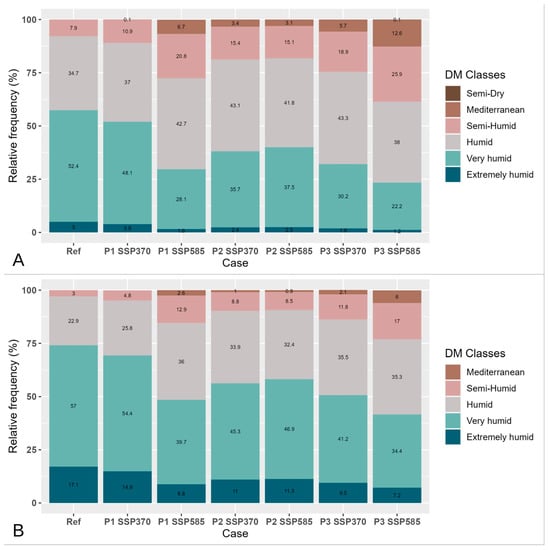
Figure 9.
The de Martonne classes’ spatial relative frequency over the agricultural (A) and natural areas (B) of the Czech Republic.
3.2.4. Hungary (HU)
Owing to intense xerothermic future trends, the agricultural areas of HU are foreseen to be mostly impacted by the semi-humid and Mediterranean bioclimates at P2 and P3 of both scenarios (Figure 10A). The areas subjected to the Mediterranean conditions, in particular, are projected to occupy significant parts under both the SSP370 and SSP585 by 2100 (52.9% and 64.9%, respectively). The more extreme SSP585 is apparently more influential, especially at P3, where the semi-dry category is also depicted at a comparably smaller relative frequency (7% in P3 SSP585). It should be emphasized that in the long-term (P3) a significant part of the agricultural areas which is expected to be impacted by both the Mediterranean and semi-humid regimes (approximately 87% under the SSP370 and over 90% under the SSP585) will demand supplementary irrigation. Additionally, the intense dry thermal trends over a relatively small area (7%) characterized by semi-dry conditions will force the dependency on irrigation water supply.
A similar evolution pattern may be described for the natural areas of HU (Figure 10B), where a consecutive increase of the semi-dry and Mediterranean classes’ relative frequencies is projected under both scenarios. The highest distribution of the Mediterranean category is demonstrated at P3 (43.8% vs. 30.4% in P3 SSP370 and 0.0% in Ref accompanied by a possible limited occurrence of the semi-dry category (2.8% in P3 SSP585).
According to Nistor’s investigation [79] (see Section 3.2.1.), for both periods 2011–2040 and 2041–2070 (respective P1 and P2 periods of the present study) under the optimistic scenario (RCP4.5), a relatively intense xerothermicity trend due to CC was displayed over most of HU’s surface area. These impacts were demonstrated by the substantial distribution mainly of the Mediterranean class followed by the semi-humid in both examined periods of both scenarios, mostly over the agricultural areas (as in the present study’s findings at P1 and P2 in Figure 10A). At the long-term (2041–2070) time frame (P2 of the present survey), more intense xerothermic trends were foreseen by the domination of the Mediterranean conditions and the spatial existence of the even drier semi-dry category over the agricultural areas as exhibited in the current study (Figure 10A).
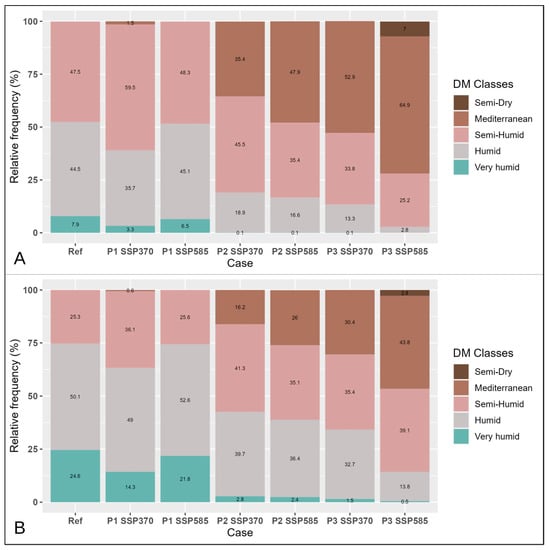
Figure 10.
The de Martonne classes’ spatial relative frequency over the agricultural (A) and natural areas (B) of Hungary.
3.2.5. Slovakia (SK)
Projections on the alteration of SK’s agricultural areas’ bioclimate reveal drier and warmer conditions as generally illustrated by the increase in the Mediterranean class’ relative frequency at P2 and P3 of the SSP370 and mostly at P3 of the SSP585 (23.3% vs. 10.8% in P3 SSP370 and 0.0% in Ref) (Figure 11A). With respect to the Ref, a higher frequency of the semi-humid category results under both scenarios, mostly peaking at P3 SSP370 (34% vs. 28.7% in P3 SSP585 and 13.2% in Ref). Concerning the Ref, a consecutive spatial declining trend of the remaining more humid de Martonne categories is expected in all examined cases, with the SSP585 exhibiting a more intense impact and especially at P3 (e.g., 24.8% vs. 28.6% in P3 SSP370 and 41.1% in Ref, for the humid class). The overall substantial spatial occupation of the agricultural areas by the Mediterranean and semi-humid classes, especially at P3 SSP585 (over 50%), indicates the need for supplementary irrigation raised by 2100.
A relatively small expansion in the natural areas of SK is foreseen to be subjected to more xerothermic bioclimatic conditions (Figure 11B). Increasing trends result for the first three classifications (Mediterranean, semi-humid and humid), with the case of P3 SSP585 demonstrating a slightly higher impact (e.g., 3.7% vs. 1.1% in P3 SSP370 and 0.0% in Ref, for the Mediterranean category). This is the situation also for the concomitant limiting of the areas with more humid conditions mostly evidenced under the SSP585 and particularly at P3 (e.g., 44% vs. 47.3% in P3 SSP370 and 53.4% in Ref, for the very humid class).
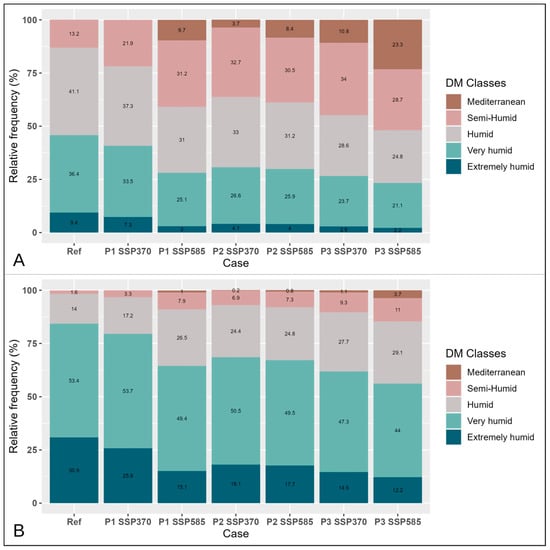
Figure 11.
The de Martonne classes’ spatial relative frequency over the agricultural (A) and natural areas (B) of Slovakia.
3.2.6. Total Area Spatial Statistics
Results from the de Martonne classes’ spatial distribution over the entire investigated agricultural and natural areas are illustrated in Figure 12. Overall, results show more intense future warming up and drying of the bioclimate over the lowland agricultural areas in contrast to the natural areas which correspond to higher altitudinal landscapes. Both scenarios are expected to induce the bioclimatic modification of the agricultural areas (Figure 12A) given the increase of the semi-humid and mostly of the Mediterranean frequencies in comparison with Ref. In all cases, higher impacts are projected to occur by the extreme scenario’s longer time frame given the higher distribution of the Mediterranean category demonstrated at P3 SSP585 (30.1% vs. 21.1% in P3 SSP370 and 0.0% in Ref) and the appearance of the drier semi-dry category (2.3%).
It is apparent that more than half of CEu’s agricultural surface area (total of 53.4% for the semi-dry, Mediterranean and semi-humid classes) will be in need of supplementary irrigation by 2100 under the extreme SSP858 scenario. Furthermore, the occurrence at P3 SSP585 of the semi-dry bioclimate raises concerns about the fate of agriculture, given the probable subjection of agricultural productivity to severe dependence on irrigation in the far future.
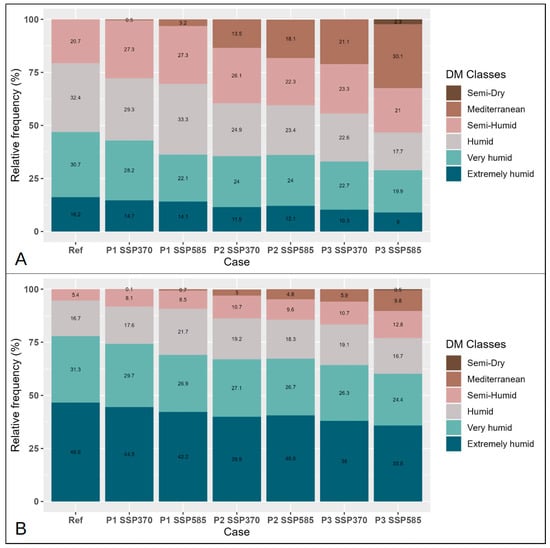
Figure 12.
The de Martonne classes’ spatial relative frequency over the agricultural (A) and natural areas (B) of the CEu.
Compared to the Ref, the increasing spatial distribution of the drier Mediterranean, semi-humid and humid categories (at the expense of the very humid and extremely humid) is expected over the natural areas of CEu under the SSP370 and mostly under the SSP585 (Figure 12B). A more significant influence is demonstrated by the latter scenario, especially on the frequencies of the Mediterranean and semi-humid classes at P3 (e.g., 9.8% vs. 5.9% in P3 SSP370 and 0.0% in Ref, for the Mediterranean class). The significant impact of the SSP585 is further depicted by the distribution (0.5%) of the semi-dry category, which is projected to influence a small part of CEu’s natural areas.
3.2.7. Management and Policy Implications
The study’s results support that drastic and significant changes in bioclimatic conditions will occur in the future in CEu. These findings align with the recent study conducted by Hinze et al. [101], which suggests the possibility of drastic shifts in vegetation potentials in Europe in the upcoming decades, especially for natural vegetation, that will directly impact species due to suitable habitat loss. This also implies that in many areas, CC could drive current vegetation outside its climatic suitability long before its replacement by future, suitable natural vegetation by means of natural dispersal and succession [101].
Considering the aforementioned conditions, conservation and resilience measures and actions should be prioritized in highly affected areas and consider the expansion or modification of protected areas network boundaries (e.g., for National Parks, Natura 2000 sites) in order to protect endangered or potentially endangered species, habitats, and ecosystem services, e.g., with ex-situ species conservation, habitat restoration and amelioration, identification and protection of climatic refugia, etc. [102]. In order to protect future patterns of biodiversity, conservation strategies must extend their planning further into the future [103].
Currently, the European Green Deal [104] provides the framework in which management and policy decisions should be set and applied, following all relevant strategies for, e.g., biodiversity, water resources, forests, and agriculture simultaneously. However, a standardized monitoring and reporting scheme is needed to systematically assess ongoing changes in order to plan and implement conservation, protection, and CC mitigation measures. For instance, the predicted bioclimatic change will potentially provide adequate bioclimate (mainly semi-arid and Mediterranean classes) for large wildfires, affecting protected areas, agricultural land, infrastructure, and human life. Additionally, predicted conditions and bioclimatic zones change will set food security at stake, highlighting that current cultivation schemes, plant species and varieties should be carefully assessed for their resilience and productivity in the future and/or propose and prepare alternative practices and/or species for the upcoming environmental and climate status [105].
Moreover, the study results align with the scenario-building approach for natural resources management, which incorporates future climatic scenarios alongside current and future demand scenarios [106]. Especially for water resources, it is highlighted that mismanagement may lead to water body shrinkage, lakes’ deterioration, etc., an issue that the international literature has pointed out as a new and global threat [107,108,109,110]. Smart or precision agriculture, especially water-related implementations, could provide sustainable solutions due to potential irrigation water scarcity [111,112,113].
CC significantly impacts water resources, including irrigation water, in Europe [114,115,116]. Rising temperatures, changing precipitation patterns, and increased frequency of extreme weather events are altering the availability and distribution of water across the continent [117,118,119]. This study’s findings align with the previously published research, which raises awareness of the consequences of higher temperatures and lower or altered precipitation patterns [120,121,122]. As presented by the maps and the bar plots, according to the examined GHG emissions scenarios, there will be alterations to the bioclimatic status, especially in the agricultural areas of south and southeastern Hungary, in the southwestern part of Slovakia, in the northeastern part of Austria and in the northwestern and southern part of the Czech Republic. The impact of CC is higher in the lower areas in terms of altitude, forming scenarios of higher irrigatable water demand in the future. This is probably a sign of an in-depth replanning of agriculture strategies and practices from the country to the stakeholder level concerning future water scarcity, shifts in precipitation, droughts, and future food demands.
The emergency for local-, large-scale mitigation and adaptation strategies development and implementation for resilient ecosystems is highlighted, which requires and should include public awareness raising and stakeholder participation in the decision-making process [123], in order to sustainably adapt the daily practice to future conditions, under the framework of co-designed socio-economic and environmental resilience.
4. Conclusions
This study provides the needed fine-scale, spatially explicit information for future conditions and can adequately support integrated spatial planning not only for rural and natural areas but for the total territory. In fact, future projections highlight more than ever the need to co-design nature protection and conservation alongside rural development and other socio-economic activities.
The main findings of the present survey may be summarized as follows:
An overall change in the bioclimatic conditions is projected to occur over the CEu under both investigated scenarios (SSP370 and SSP585). According to the results, the analyzed countries’ bioclimate will form a “more Mediterranean” character with related ecological and agricultural challenges.
The extreme SSP585 scenario results as more impactful over both area categories (agricultural and natural).
A more intense dry thermal regime is expected to impact approximately the right half of the CEuan territory (Czech Republic, Slovakia, Hungary) and mainly the southeastern part (Hungary).
A continuous modification/increase of the drier de Martonne classes’ spatial distribution (e.g., Mediterranean, semi-humid classes) at the expense of the more humid ones (e.g., very humid, extremely humid classes) is foreseen in most of the examined cases.
In most investigated cases, a stronger xerothermic trend is expected to be evidenced in the long-term time frame (P3: 2071–2100).
On a country level, the majorly altered bioclimatic footprint will likely appear over Hungary’s agricultural and natural areas, where the Mediterranean bioclimate is projected to dominate by the end of the century.
The potential occurrence of the semi-dry bioclimate over southern Hungary pinpoints the area most intensely impacted by the bioclimatic change, where the probable dependence on irrigation will determine the fate of agricultural productivity in the far future.
By the end of the century, based overall on the potential evolution of the drier bioclimatic conditions under the extreme SSP585 scenario, it becomes evident that the water requirements for the sustainability of agriculture will increase significantly in the long run for the Czech Republic, Slovakia and to a great degree for Hungary. These requirements will mainly involve supplementary irrigation owing to the expansion of the agricultural areas with Mediterranean and semi-humid bioclimates and the former’s domination over Hungary.
The global concern, social sensitivity, and individual responsibility towards reducing greenhouse gas emissions and promptly implementing mitigation and adaptation strategies are of fundamental importance, principally in the most vulnerable areas (e.g., in HU).
By conceptualizing the continuous evolution of the bioclimate towards more dry thermal regimes, the sustainability of agriculture must be prioritized and framed by the accomplishment of effective irrigation practices to cope with the upcoming high water demands of cultivation.
In the future, efficient irrigation tactics must be implemented over pressurized agricultural areas of CEu dominated by Mediterranean and semi-dry conditions (e.g., both over the Great Hungarian Plain) that will need supplementary irrigation or depend on irrigation, respectively.
The demonstrated thematic mapping and representations potentially serve as beneficial scientific information tools in developing public awareness and decision-making, especially for protected areas.
The present study’s findings pinpoint and once again confirm the de Martonne index’s functionality and capability in exhibiting bioclimatic regimes, which in the current survey involves the bioclimatic footprint of CEu’s future natural and agricultural areas.
Future investigation planning may include more bioclimatic indices, ultra-high resolution mapping and spatial analysis to enrich agricultural and natural conservation researchers’ toolbox due to climate change.
Author Contributions
Conceptualization, I.C.; Methodology, I.C.; Investigation, F.D. and I.C.; Resources, F.D.; Original Preparation and Writing, F.D.; Writing on Data and Methods, I.C.; Method Application and computation of Results, I.C.; Table and Figures, I.C.; Discussion for natural areas implications and policies I.P.K. and P.D. Review and Editing, F.D.; Review and Editing, I.P.K. and P.D. All authors have read and agreed to the published version of the manuscript.
Funding
This research received no external funding.
Data Availability Statement
Ultra-high resolution maps which are presented in this study and the R code are available upon request.
Acknowledgments
Authors would like to thank Jeffrey S. Evans for the very useful clarifications about the usage of the SpatialEco package application.
Conflicts of Interest
The authors declare no conflict of interest.
References
- Vlami, V.; Kokkoris, I.P.; Zogaris, S.; Cartalis, C.; Kehayias, G.; Dimopoulos, P. Cultural Landscapes and Attributes of “Culturalness” in Protected Areas: An Exploratory Assessment in Greece. Sci. Total Environ. 2017, 595, 229–243. [Google Scholar] [CrossRef] [PubMed]
- Malhi, Y.; Franklin, J.; Seddon, N.; Solan, M.; Turner, M.G.; Field, C.B.; Knowlton, N. Climate Change and Ecosystems: Threats, Opportunities and Solutions. Philos. Trans. R. Soc. Lond. B. Biol. Sci. 2020, 375, 20190104. [Google Scholar] [CrossRef] [PubMed]
- Charalampopoulos, I.; Droulia, F. The Agro-Meteorological Caused Famines as an Evolutionary Factor in the Formation of Civilisation and History: Representative Cases in Europe. Climate 2021, 9, 5. [Google Scholar] [CrossRef]
- Charalampopoulos, I. Agrometeorological Conditions and Agroclimatic Trends for the Maize and Wheat Crops in the Balkan Region. Atmosphere 2021, 12, 671. [Google Scholar] [CrossRef]
- Charalampopoulos, I.; Polychroni, I.; Psomiadis, E.; Nastos, P. Spatiotemporal Estimation of the Olive and Vine Cultivations’ Growing Degree Days in the Balkans Region. Atmosphere 2021, 12, 148. [Google Scholar] [CrossRef]
- Charalampopoulos, I.; Droulia, F. Frost Conditions Due to Climate Change in South-Eastern Europe via a High-Spatiotemporal-Resolution Dataset. Atmosphere 2022, 13, 1407. [Google Scholar] [CrossRef]
- Charalampopoulos, I.; Droulia, F.; Evans, J. The Bioclimatic Change of the Agricultural and Natural Areas of the Adriatic Coastal Countries. Sustainability 2023, 15, 4867. [Google Scholar] [CrossRef]
- Pörtner, H.-O.; Roberts, D.C.; Tignor, M.; Poloczanska, E.S.; Mintenbeck, K.; Alegria, A.; Craig, M.; Langsdorf, S.; Löschke, S.; Möller, V.; et al. Climate Change 2022: Impacts, Adaptation and Vulnerability. Contribution of Working Group II to the Sixth Assessment Report of the Intergovernmental Panel on Climate Change; Cambridge University Press: Cambridge, UK; New York, NY, USA, 2022; ISBN 978-1-00-932584-4. [Google Scholar]
- Rannow, S.; Neubert, M. Managing Protected Areas in Central and Eastern Europe under Climate Change; Advances in Global Change Research; Springer Nature: Dordrecht, The Netherlands; Heidelberg, German; New York, NY, USA; London, UK, 2014; Volume 58, ISBN 978-94-007-7959-4. [Google Scholar]
- Droulia, F.; Charalampopoulos, I. Future Climate Change Impacts on European Viticulture: A Review on Recent Scientific Advances. Atmosphere 2021, 12, 495. [Google Scholar] [CrossRef]
- Rakonczai, J. Effects and Consequences of Global Climate Change in the Carpathian Basin. In Climate Change-Geophysical Foundations and Ecological Effects; Blanco, J., Kheradmand, H., Eds.; IntechOpen: Rijeka, Croatia, 2011; p. 536, Chapter 15; ISBN 978-953-307-419-1. [Google Scholar]
- Moberg, A.; Jones, P.D. Trends in Indices for Extremes in Daily Temperature and Precipitation in Central and Western Europe, 1901–1999. Int. J. Climatol. 2005, 25, 1149–1171. [Google Scholar] [CrossRef]
- Trnka, M.; Balek, J.; Zahradníček, P.; Eitzinger, J.; Formayer, H.; Turňa, M.; Nejedlík, P.; Semerádová, D.; Hlavinka, P.; Brázdil, R. Drought Trends over Part of Central Europe between 1961 and 2014. Clim. Res. 2016, 70, 143–160. [Google Scholar] [CrossRef]
- Spinoni, J.; Naumann, G.; Vogt, J.; Barbosa, P. Meteorological Droughts in Europe: Events and Impacts-Past Trends and Future Projections; Publications Office of the European Union: Luxembourg, 2016; ISBN 978-92-79-55098-0. [Google Scholar]
- Hungary. Biennial Reports (BR). BR 3. National Communication (NC). NC 7.|UNFCCC. Available online: https://unfccc.int/documents/28936 (accessed on 8 March 2023).
- Kobuliev, M. Projections of Future Anthropogenic Climate Change in Switzerland Using Multi-GCM Modeling. Model. Earth Syst. Environ. 2023. [Google Scholar] [CrossRef]
- Olefs, M.; Formayer, H.; Gobiet, A.; Marke, T.; Schöner, W.; Revesz, M. Past and Future Changes of the Austrian Climate–Importance for Tourism. J. Outdoor Recreat. Tour. 2021, 34, 100395. [Google Scholar] [CrossRef]
- Slovakia. Biennial Reports (BR). BR 3. National Communication (NC). NC 7.|UNFCCC. Available online: https://unfccc.int/documents/198289 (accessed on 3 March 2023).
- Czechia. Biennial Report (BR). BR 3. National Communication (NC). NC 7.|UNFCCC. Available online: https://unfccc.int/documents/198236 (accessed on 3 March 2023).
- Sábitz, J.; Pongrácz, R.; Bartholy, J. Estimated Changes of Drought Tendency in the Carpathian Basin. Hungarian Geogr. Bull. 2014, 63, 365–378. [Google Scholar] [CrossRef]
- Bartholy, J.; Pongrácz, R.; Hollósi, B. Analysis of Projected Drought Hazards for Hungary. Adv. Geosci. 2013, 35, 61–66. [Google Scholar] [CrossRef]
- Dubrovsky, M.; Svoboda, M.D.; Trnka, M.; Hayes, M.J.; Wilhite, D.A.; Zalud, Z.; Hlavinka, P. Application of Relative Drought Indices in Assessing Climate-Change Impacts on Drought Conditions in Czechia. Theor. Appl. Climatol. 2009, 96, 155–171. [Google Scholar] [CrossRef]
- Kertész, Á. Is Desertification a Problem in Hungary? Landsc. Environ. 2016, 10, 242–247. [Google Scholar] [CrossRef]
- Vido, J.; Nalevanková, P.; Valach, J.; Šustek, Z.; Tadesse, T. Drought Analyses of the Horné Požitavie Region (Slovakia) in the Period 1966–2013. Adv. Meteorol. 2019, 2019, e3576285. [Google Scholar] [CrossRef]
- Alsafadi, K.; Mohammed, S.A.; Ayugi, B.; Sharaf, M.; Harsányi, E. Spatial–Temporal Evolution of Drought Characteristics Over Hungary Between 1961 and 2010. Pure Appl. Geophys. 2020, 177, 3961–3978. [Google Scholar] [CrossRef]
- Gálos, B.; Lorenz, P.; Jacob, D. Will Dry Events Occur More Often in Hungary in the Future? Environ. Res. Lett. 2007, 2, 034006. [Google Scholar] [CrossRef]
- Spinoni, J.; Lakatos, M.; Szentimrey, T.; Bihari, Z.; Szalai, S.; Vogt, J.; Antofie, T. Heat and Cold Waves Trends in the Carpathian Region from 1961 to 2010. Int. J. Climatol. 2015, 35, 4197–4209. [Google Scholar] [CrossRef]
- Forzieri, G.; Feyen, L.; Russo, S.; Vousdoukas, M.; Alfieri, L.; Outten, S.; Migliavacca, M.; Bianchi, A.; Rojas, R.; Cid, A. Multi-Hazard Assessment in Europe under Climate Change. Clim. Chang. 2016, 137, 105–119. [Google Scholar] [CrossRef]
- Fiala, K.; Blanka, V.; Ladányi, Z.; Szilassi, P.; Benyhe, B.; Dolinaj, D.; Pálfai, I. Drought Severity and Its Effect on Agricultural Production in the Hungarian-Serbian Cross-Border Area. J. Environ. Geogr. 2014, 7, 43–51. [Google Scholar] [CrossRef]
- Finger, R.; Hediger, W.; Schmid, S. Irrigation as Adaptation Strategy to Climate Change—A Biophysical and Economic Appraisal for Swiss Maize Production. Clim. Chang. 2011, 105, 509–528. [Google Scholar] [CrossRef]
- Huzsvai, L.; Zsembeli, J.; Kovács, E.; Juhász, C. Can Technological Development Compensate for the Unfavorable Impacts of Climate Change? Conclusions from 50 Years of Maize (Zea mays L.) Production in Hungary. Atmosphere 2020, 11, 1350. [Google Scholar] [CrossRef]
- Forstner, V.; Vremec, M.; Herndl, M.; Birk, S. Effects of Dry Spells on Soil Moisture and Yield Anomalies at a Montane Managed Grassland Site: A Lysimeter Climate Experiment. Ecohydrology 2022, 16, e2518. [Google Scholar] [CrossRef]
- Bakucs, Z.; Fertő, I.; Vígh, E. Crop Productivity and Climatic Conditions: Evidence from Hungary. Agriculture 2020, 10, 421. [Google Scholar] [CrossRef]
- Spinoni, J.; Vogt, J.V.; Naumann, G.; Barbosa, P.; Dosio, A. Will Drought Events Become More Frequent and Severe in Europe? Int. J. Climatol. 2018, 38, 1718–1736. [Google Scholar] [CrossRef]
- Nistor, M.-M.; Cheval, S.; Gualtieri, A.F.; Dumitrescu, A.; Boţan, V.E.; Berni, A.; Hognogi, G.; Irimuş, I.A.; Porumb-Ghiurco, C.G. Crop Evapotranspiration Assessment under Climate Change in the Pannonian Basin during 1991–2050. Meteorol. Appl. 2017, 24, 84–91. [Google Scholar] [CrossRef]
- Kovács, A.; Jakab, A. Modelling the Impacts of Climate Change on Shallow Groundwater Conditions in Hungary. Water 2021, 13, 668. [Google Scholar] [CrossRef]
- Trnka, M.; Brázdil, R.; Možný, M.; Štěpánek, P.; Dobrovolný, P.; Zahradníček, P.; Balek, J.; Semerádová, D.; Dubrovský, M.; Hlavinka, P.; et al. Soil Moisture Trends in the Czech Republic between 1961 and 2012. Int. J. Climatol. 2015, 35, 3733–3747. [Google Scholar] [CrossRef]
- Gelybó, G.; Tóth, E.; Farkas, C.; Horel, Á.; Kása, I.; Bakacsi, Z. Potential Impacts of Climate Change on Soil Properties. Agrokem 2018, 67, 121–141. [Google Scholar] [CrossRef]
- Trnka, M.; Semerádová, D.; Novotný, I.; Dumbrovský, M.; Drbal, K.; ek Pavlík, F.; Vopravil, J.; Vizina, A.; Balek, J.; Hlavinka, P. Assessing the Combined Hazards of Drought, Soil Erosion and Local Flooding on Agricultural Land: A Czech Case Study. Clim. Res. 2016, 70, 231–249. [Google Scholar] [CrossRef]
- Schneider, L.; Comte, V.; Rebetez, M. Increasingly Favourable Winter Temperature Conditions for Major Crop and Forest Insect Pest Species in Switzerland. Agric. For. Meteorol. 2021, 298–299, 108315. [Google Scholar] [CrossRef]
- Stoeckli, S.; Felber, R.; Haye, T. Current Distribution and Voltinism of the Brown Marmorated Stink Bug, Halyomorpha Halys, in Switzerland and Its Response to Climate Change Using a High-Resolution CLIMEX Model. Int. J. Biometeorol. 2020, 64, 2019–2032. [Google Scholar] [CrossRef]
- Droulia, F.; Charalampopoulos, I. A Review on the Observed Climate Change in Europe and Its Impacts on Viticulture. Atmosphere 2022, 13, 837. [Google Scholar] [CrossRef]
- Čimo, J.; Aydın, E.; Šinka, K.; Tárník, A.; Kišš, V.; Halaj, P.; Toková, L.; Kotuš, T. Change in the Length of the Vegetation Period of Tomato (Solanum lycopersicum L.), White Cabbage (Brassica oleracea L. Var. Capitata) and Carrot (Daucus carota L.) Due to Climate Change in Slovakia. Agronomy 2020, 10, 1110. [Google Scholar] [CrossRef]
- Trnka, M.; Brázdil, R.; Balek, J.; Dubrovský, M.; Eitzinger, J.; Hlavinka, P.; Chuchma, F.; Možný, M.; Prášil, I.; Růžek, P.; et al. Observed Changes in the Agroclimatic Zones in the Czech Republic between 1961 and 2019. Plant Soil Environ. 2021, 67, 154–163. [Google Scholar] [CrossRef]
- Pavlik, P.; Vlckova, V.; Machar, I. Changes to Land Area Used for Grain Maize Production in Central Europe Due to Predicted Climate Change. Int. J. Agron. 2019, 2019, e9168285. [Google Scholar] [CrossRef]
- Gaál, M.; Quiroga, S.; Fernandez-Haddad, Z. Potential Impacts of Climate Change on Agricultural Land Use Suitability of the Hungarian Counties. Reg. Environ. Chang. 2014, 14, 597–610. [Google Scholar] [CrossRef]
- Dinca, L.; Nita, M.D.; Hofgaard, A.; Alados, C.L.; Broll, G.; Borz, S.A.; Wertz, B.; Monteiro, A.T. Forests Dynamics in the Montane-Alpine Boundary: A Comparative Study Using Satellite Imagery and Climate Data. Clim. Res. 2017, 73, 97–110. [Google Scholar] [CrossRef]
- Fuhrer, J.; Beniston, M.; Fischlin, A.; Frei, C.; Goyette, S.; Jasper, K.; Pfister, C. Climate Risks and Their Impact on Agriculture and Forests in Switzerland. Clim. Chang. 2006, 79, 79–102. [Google Scholar] [CrossRef]
- Somogyi, Z. Projected Effects of Climate Change on the Carbon Stocks of European Beech (Fagus sylvatica L.) Forests in Zala County, Hungary. Lesn. Cas. For. J. 2016, 62, 3–14. [Google Scholar] [CrossRef]
- Lamprecht, A.; Semenchuk, P.R.; Steinbauer, K.; Winkler, M.; Pauli, H. Climate Change Leads to Accelerated Transformation of High-Elevation Vegetation in the Central Alps. New Phytol. 2018, 220, 447–459. [Google Scholar] [CrossRef] [PubMed]
- Rogora, M.; Frate, L.; Carranza, M.L.; Freppaz, M.; Stanisci, A.; Bertani, I.; Bottarin, R.; Brambilla, A.; Canullo, R.; Carbognani, M.; et al. Assessment of Climate Change Effects on Mountain Ecosystems through a Cross-Site Analysis in the Alps and Apennines. Sci. Total Environ. 2018, 624, 1429–1442. [Google Scholar] [CrossRef] [PubMed]
- Henne, P.D.; Bigalke, M.; Büntgen, U.; Colombaroli, D.; Conedera, M.; Feller, U.; Frank, D.; Fuhrer, J.; Grosjean, M.; Heiri, O.; et al. An Empirical Perspective for Understanding Climate Change Impacts in Switzerland. Reg. Environ. Chang. 2018, 18, 205–221. [Google Scholar] [CrossRef]
- Szabó, B.; Vincze, E.; Czúcz, B. Flowering Phenological Changes in Relation to Climate Change in Hungary. Int. J. Biometeorol. 2016, 60, 1347–1356. [Google Scholar] [CrossRef]
- Bodnár, L.; Pántya, P. The Threat of Forest and Vegetation Fires and the Possibilities of Intervention in Hungary. AARMS 2019, 18, 21–31. [Google Scholar] [CrossRef]
- Büntgen, U.; Liebhold, A.; Nievergelt, D.; Wermelinger, B.; Roques, A.; Reinig, F.; Krusic, P.J.; Piermattei, A.; Egli, S.; Cherubini, P.; et al. Return of the Moth: Rethinking the Effect of Climate on Insect Outbreaks. Oecologia 2020, 192, 543–552. [Google Scholar] [CrossRef]
- Móricz, N.; Garamszegi, B.; Rasztovits, E.; Bidló, A.; Horváth, A.; Jagicza, A.; Illés, G.; Vekerdy, Z.; Somogyi, Z.; Gálos, B. Recent Drought-Induced Vitality Decline of Black Pine (Pinus Nigra Arn.) in South-West Hungary—Is This Drought-Resistant Species under Threat by Climate Change? Forests 2018, 9, 414. [Google Scholar] [CrossRef]
- Mezei, P.; Jakuš, R.; Pennerstorfer, J.; Havašová, M.; Škvarenina, J.; Ferenčík, J.; Slivinský, J.; Bičárová, S.; Bilčík, D.; Blaženec, M.; et al. Storms, Temperature Maxima and the Eurasian Spruce Bark Beetle Ips Typographus—An Infernal Trio in Norway Spruce Forests of the Central European High Tatra Mountains. Agric. For. Meteorol. 2017, 242, 85–95. [Google Scholar] [CrossRef]
- Kertész, Á.; Křeček, J. Landscape Degradation in the World and in Hungary. Hungarian Geogr. Bull. 2019, 68, 201–221. [Google Scholar] [CrossRef]
- Kovács, F.; Gulácsi, A. Spectral Index-Based Monitoring (2000–2017) in Lowland Forests to Evaluate the Effects of Climate Change. Geosciences 2019, 9, 411. [Google Scholar] [CrossRef]
- Rutishauser, T.; Jeanneret, F.; Brügger, R.; Brugnara, Y.; Röthlisberger, C.; Bernasconi, A.; Bangerter, P.; Portenier, C.; Villiger, L.; Lehmann, D.; et al. The BernClim Plant Phenological Data Set from the Canton of Bern (Switzerland) 1970–2018. Earth Syst. Sci. Data 2019, 11, 1645–1654. [Google Scholar] [CrossRef]
- Peringer, A.; Frank, V.; Snell, R.S. Climate Change Simulations in Alpine Summer Pastures Suggest a Disruption of Current Vegetation Zonation. Glob. Ecol. Conserv. 2022, 37, e02140. [Google Scholar] [CrossRef]
- Baltas, E. Spatial distribution of climatic indices in northern Greece. Meteorol. Appl. 2007, 14, 69–78. [Google Scholar] [CrossRef]
- Passarella, G.; Bruno, D.; Lay-Ekuakille, A.; Maggi, S.; Masciale, R.; Zaccaria, D. Spatial and Temporal Classification of Coastal Regions Using Bioclimatic Indices in a Mediterranean Environment. Sci. Total Environ. 2020, 700, 134415. [Google Scholar] [CrossRef]
- Botta-Dukát, Z.; Chytrý, M.; Hájková, P.; Havlová, M. Vegetation of Lowland Wet Meadows along a Climatic Continentality Gradient in Central Europe. Preslia 2005, 77, 89–111. [Google Scholar]
- Moral, F.J.; Aguirado, C.; Alberdi, V.; Paniagua, L.L.; García-Martín, A.; Rebollo, F.J. Future Scenarios for Aridity under Conditions of Global Climate Change in Extremadura, Southwestern Spain. Land 2023, 12, 536. [Google Scholar] [CrossRef]
- Gavrilov, M.B.; An, W.; Xu, C.; Radaković, M.G.; Hao, Q.; Yang, F.; Guo, Z.; Perić, Z.; Gavrilov, G.; Marković, S.B. Independent Aridity and Drought Pieces of Evidence Based on Meteorological Data and Tree Ring Data in Southeast Banat, Vojvodina, Serbia. Atmosphere 2019, 10, 586. [Google Scholar] [CrossRef]
- Gebremedhin, M.A.; Abraha, A.Z.; Fenta, A.A. Changes in Future Climate Indices Using Statistical Downscaling Model in the Upper Baro Basin of Ethiopia. Theor. Appl. Climatol. 2018, 133, 39–46. [Google Scholar] [CrossRef]
- Černý, J.; Pokorný, R.; Vejpustková, M.; Šrámek, V.; Bednář, P. Air Temperature Is the Main Driving Factor of Radiation Use Efficiency and Carbon Storage of Mature Norway Spruce Stands under Global Climate Change. Int. J. Biometeorol. 2020, 64, 1599–1611. [Google Scholar] [CrossRef] [PubMed]
- Ugarković, D.; Paulić, V.; Šapić, I.; Poljak, I.; Ančić, M.; Tikvić, I.; Stankić, I. Climatic Relationship of Vegetation in Forest Stands in the Mediterranean Vegetation Belt of the Eastern Adriatic. Atmosphere 2022, 13, 1709. [Google Scholar] [CrossRef]
- Pardos, M.; del Río, M.; Pretzsch, H.; Jactel, H.; Bielak, K.; Bravo, F.; Brazaitis, G.; Defossez, E.; Engel, M.; Godvod, K.; et al. The Greater Resilience of Mixed Forests to Drought Mainly Depends on Their Composition: Analysis along a Climate Gradient across Europe. For. Ecol. Manag. 2021, 481, 118687. [Google Scholar] [CrossRef]
- Engel, M.; Vospernik, S.; Toïgo, M.; Morin, X.; Tomao, A.; Trotta, C.; Steckel, M.; Barbati, A.; Nothdurft, A.; Pretzsch, H.; et al. Simulating the Effects of Thinning and Species Mixing on Stands of Oak (Quercus petraea (Matt.) Liebl./Quercus robur L.) and Pine (Pinus sylvestris L.) across Europe. Ecol. Model. 2021, 442, 109406. [Google Scholar] [CrossRef]
- Francaviglia, R.; Álvaro-Fuentes, J.; Di Bene, C.; Gai, L.; Regina, K.; Turtola, E. Diversified Arable Cropping Systems and Management Schemes in Selected European Regions Have Positive Effects on Soil Organic Carbon Content. Agriculture 2019, 9, 261. [Google Scholar] [CrossRef]
- García-Martín, A.; Aguirado, C.; Paniagua, L.L.; Alberdi, V.; Moral, F.J.; Rebollo, F.J. Spatial Analysis of Aridity during Grapevine Growth Stages in Extremadura (Southwest Spain). Land 2022, 11, 2125. [Google Scholar] [CrossRef]
- Blanka, V.; Mezősi, G.; Meyer, B. Projected Changes in the Drought Hazard in Hungary Due to Climate Change. Idojaras 2013, 117, 219–237. [Google Scholar]
- Ladányi, Z.; Blanka, V.; Meyer, B.; Mezősi, G.; Rakonczai, J. Multi-Indicator Sensitivity Analysis of Climate Change Effects on Landscapes in the Kiskunság National Park, Hungary. Ecol. Indic. 2015, 58, 8–20. [Google Scholar] [CrossRef]
- Gavrilov, M.B.; Radaković, M.G.; Sipos, G.; Mezősi, G.; Gavrilov, G.; Lukić, T.; Basarin, B.; Benyhe, B.; Fiala, K.; Kozák, P.; et al. Aridity in the Central and Southern Pannonian Basin. Atmosphere 2020, 11, 1269. [Google Scholar] [CrossRef]
- Nistor, M. Climate Change Effect on Groundwater Resources in South East Europe during 21st Century. Quat. Int. 2019, 504, 171–180. [Google Scholar] [CrossRef]
- Cheval, S.; Dumitrescu, A.; Birsan, M.-V. Variability of the Aridity in the South-Eastern Europe over 1961–2050. CATENA 2017, 151, 74–86. [Google Scholar] [CrossRef]
- Karger, D.N.; Wilson, A.M.; Mahony, C.; Zimmermann, N.E.; Jetz, W. Global Daily 1 Km Land Surface Precipitation Based on Cloud Cover-Informed Downscaling. Sci. Data 2021, 8, 307. [Google Scholar] [CrossRef] [PubMed]
- Karger, D.N.; Schmatz, D.R.; Dettling, G.; Zimmermann, N.E. High-Resolution Monthly Precipitation and Temperature Time Series from 2006 to 2100. Sci. Data 2020, 7, 248. [Google Scholar] [CrossRef]
- Guo, F.; Lenoir, J.; Bonebrake, T.C. Land-Use Change Interacts with Climate to Determine Elevational Species Redistribution. Nat. Commun. 2018, 9, 1315. [Google Scholar] [CrossRef] [PubMed]
- Margalef-Marrase, J.; Pérez-Navarro, M.Á.; Lloret, F. Relationship between Heatwave-Induced Forest Die-off and Climatic Suitability in Multiple Tree Species. Glob. Chang. Biol. 2020, 26, 3134–3146. [Google Scholar] [CrossRef] [PubMed]
- Christia, C.; Giordani, G.; Papastergiadou, E. Environmental Variability and Macrophyte Assemblages in Coastal Lagoon Types of Western Greece (Mediterranean Sea). Water 2018, 10, 151. [Google Scholar] [CrossRef]
- Lembrechts, J.J.; Lenoir, J.; Roth, N.; Hattab, T.; Milbau, A.; Haider, S.; Pellissier, L.; Pauchard, A.; Ratier Backes, A.; Dimarco, R.D.; et al. Comparing Temperature Data Sources for Use in Species Distribution Models: From in-Situ Logging to Remote Sensing. Glob. Ecol. Biogeogr. 2019, 28, 1578–1596. [Google Scholar] [CrossRef]
- Evans, J.S.; Murphy, M.A.; Ram, K. SpatialEco: Spatial Analysis and Modelling Utilities. Available online: https://CRAN.R-project.org/package=spatialEco (accessed on 12 December 2022).
- Wickham, H. The Tidyverse. Available online: https://www.tidyverse.org/ (accessed on 15 April 2023).
- Hijmans, R.J.; Bivand, R.; Forner, K.; Ooms, J.; Pebesma, E.; Sumner, M.D. Terra: Spatial Data Analysis. Available online: https://CRAN.R-project.org/package=terra (accessed on 7 July 2022).
- Milovanović, B.; Schubert, S.; Radovanović, M.; Vakanjac, V.R.; Schneider, C. Projected Changes in Air Temperature, Precipitation and Aridity in Serbia in the 21st Century. Int. J. Climatol. 2022, 42, 1985–2003. [Google Scholar] [CrossRef]
- Butchart, N.; Anstey, J.A.; Kawatani, Y.; Osprey, S.M.; Richter, J.H.; Wu, T. QBO Changes in CMIP6 Climate Projections. Geophys. Res. Lett. 2020, 47, e2019GL086903. [Google Scholar] [CrossRef]
- Ceglar, A.; Toreti, A.; Zampieri, M.; Royo, C. Global Loss of Climatically Suitable Areas for Durum Wheat Growth in the Future. Environ. Res. Lett. 2021, 16, 104049. [Google Scholar] [CrossRef]
- Kolanowska, M.; Michalska, E.; Konowalik, K. The Impact of Global Warming on the Niches and Pollinator Availability of Sexually Deceptive Orchid with a Single Pollen Vector. Sci. Total Environ. 2021, 795, 148850. [Google Scholar] [CrossRef] [PubMed]
- Chemura, A.; Mudereri, B.T.; Yalew, A.W.; Gornott, C. Climate Change and Specialty Coffee Potential in Ethiopia. Sci. Rep. 2021, 11, 8097. [Google Scholar] [CrossRef] [PubMed]
- Wang, W.; Zhu, Q.; He, G.; Liu, X.; Peng, W.; Cai, Y. Impacts of Climate Change on Pine Wilt Disease Outbreaks and Associated Carbon Stock Losses. Agric. For. Meteorol. 2023, 334, 109426. [Google Scholar] [CrossRef]
- Reddy, N.M.; Saravanan, S. Extreme Precipitation Indices over India Using CMIP6: A Special Emphasis on the SSP585 Scenario. Environ. Sci. Pollut. Res. 2023, 30, 47119–47143. [Google Scholar] [CrossRef]
- Rogelj, J.; Popp, A.; Calvin, K.V.; Luderer, G.; Emmerling, J.; Gernaat, D.; Fujimori, S.; Strefler, J.; Hasegawa, T.; Marangoni, G.; et al. Scenarios towards Limiting Global Mean Temperature Increase below 1.5 °C. Nat. Clim. Chang. 2018, 8, 325–332. [Google Scholar] [CrossRef]
- Meinshausen, M.; Nicholls, Z.R.J.; Lewis, J.; Gidden, M.J.; Vogel, E.; Freund, M.; Beyerle, U.; Gessner, C.; Nauels, A.; Bauer, N.; et al. The Shared Socio-Economic Pathway (SSP) Greenhouse Gas Concentrations and Their Extensions to 2500. Geosci. Model Dev. 2020, 13, 3571–3605. [Google Scholar] [CrossRef]
- O’Neill, B.C.; Tebaldi, C.; van Vuuren, D.P.; Eyring, V.; Friedlingstein, P.; Hurtt, G.; Knutti, R.; Kriegler, E.; Lamarque, J.-F.; Lowe, J.; et al. The Scenario Model Intercomparison Project (ScenarioMIP) for CMIP6. Geosci. Model Dev. 2016, 9, 3461–3482. [Google Scholar] [CrossRef]
- de Martonne, E. Regions of Interior-Basin Drainage. Geogr. Rev. 1927, 17, 397–414. [Google Scholar] [CrossRef]
- Charalampopoulos, I.; Droulia, F.; Tsiros, I.X. Projecting Bioclimatic Change over the South-Eastern European Agricultural and Natural Areas via Ultrahigh-Resolution Analysis of the de Martonne Index. Atmosphere 2023, 14, 858. [Google Scholar] [CrossRef]
- CORINE Land Cover—European Environment Agency. Available online: http://www.eea.europa.eu/publications/COR0-landcover (accessed on 5 March 2017).
- Hinze, J.; Albrecht, A.; Michiels, H.-G. Climate-Adapted Potential Vegetation—A European Multiclass Model Estimating the Future Potential of Natural Vegetation. Forests 2023, 14, 239. [Google Scholar] [CrossRef]
- Kougioumoutzis, K.; Kokkoris, I.P.; Panitsa, M.; Trigas, P.; Strid, A.; Dimopoulos, P. Plant Diversity Patterns and Conservation Implications under Climate-Change Scenarios in the Mediterranean: The Case of Crete (Aegean, Greece). Diversity 2020, 12, 270. [Google Scholar] [CrossRef]
- Hannah, L.; Midgley, G.F.; Lovejoy, T.; Bond, W.J.; Bush, M.; Lovett, J.C.; Scott, D.; Woodward, F.I. Conservation of Biodiversity in a Changing Climate. Conserv. Biol. 2002, 16, 264–268. [Google Scholar] [CrossRef] [PubMed]
- European Commission. Communication from the Commission to the European Parliament, the Council, the European Economic and Social Committee and the Committee of the Regions Youth Opportunities Initiative; European Commission: Brussels, Belgium, 2011. [Google Scholar]
- Máté, D.; Rabbi, M.F.; Novotny, A.; Kovács, S. Grand Challenges in Central Europe: The Relationship of Food Security, Climate Change, and Energy Use. Energies 2020, 13, 5422. [Google Scholar] [CrossRef]
- Kokkoris, I.P.; Bekri, E.S.; Skuras, D.; Vlami, V.; Zogaris, S.; Maroulis, G.; Dimopoulos, D.; Dimopoulos, P. Integrating MAES Implementation into Protected Area Management under Climate Change: A Fine-Scale Application in Greece. Sci. Total Environ. 2019, 695, 133530. [Google Scholar] [CrossRef]
- Wine, M.L.; Rimmer, A.; Laronne, J.B. Agriculture, Diversions, and Drought Shrinking Galilee Sea. Sci. Total Environ. 2019, 651, 70–83. [Google Scholar] [CrossRef]
- Rodell, M.; Famiglietti, J.S.; Wiese, D.N.; Reager, J.T.; Beaudoing, H.K.; Landerer, F.W.; Lo, M.-H. Emerging Trends in Global Freshwater Availability. Nature 2018, 557, 651–659. [Google Scholar] [CrossRef]
- Fazel, N.; Torabi Haghighi, A.; Kløve, B. Analysis of Land Use and Climate Change Impacts by Comparing River Flow Records for Headwaters and Lowland Reaches. Glob. Planet. Chang. 2017, 158, 47–56. [Google Scholar] [CrossRef]
- AghaKouchak, A.; Norouzi, H.; Madani, K.; Mirchi, A.; Azarderakhsh, M.; Nazemi, A.; Nasrollahi, N.; Farahmand, A.; Mehran, A.; Hasanzadeh, E. Aral Sea Syndrome Desiccates Lake Urmia: Call for Action. J. Great Lakes Res. 2015, 41, 307–311. [Google Scholar] [CrossRef]
- Nikolaou, G.; Neocleous, D.; Christou, A.; Kitta, E.; Katsoulas, N. Implementing Sustainable Irrigation in Water-Scarce Regions under the Impact of Climate Change. Agronomy 2020, 10, 1120. [Google Scholar] [CrossRef]
- Bwambale, E.; Abagale, F.K.; Anornu, G.K. Smart Irrigation Monitoring and Control Strategies for Improving Water Use Efficiency in Precision Agriculture: A Review. Agric. Water Manag. 2022, 260, 107324. [Google Scholar] [CrossRef]
- Preite, L.; Solari, F.; Vignali, G. Technologies to Optimize the Water Consumption in Agriculture: A Systematic Review. Sustainability 2023, 15, 5975. [Google Scholar] [CrossRef]
- Masia, S.; Trabucco, A.; Spano, D.; Snyder, R.L.; Sušnik, J.; Marras, S. A Modelling Platform for Climate Change Impact on Local and Regional Crop Water Requirements. Agric. Water Manag. 2021, 255, 107005. [Google Scholar] [CrossRef]
- Iglesias, A.; Garrote, L. Adaptation Strategies for Agricultural Water Management under Climate Change in Europe. Agric. Water Manag. 2015, 155, 113–124. [Google Scholar] [CrossRef]
- Olesen, J.E.; Bindi, M. Consequences of Climate Change for European Agricultural Productivity, Land Use and Policy. Eur. J. Agron. 2002, 16, 239–262. [Google Scholar] [CrossRef]
- Faye, B.; Webber, H.; Gaiser, T.; Müller, C.; Zhang, Y.; Stella, T.; Latka, C.; Reckling, M.; Heckelei, T.; Helming, K.; et al. Climate Change Impacts on European Arable Crop Yields: Sensitivity to Assumptions about Rotations and Residue Management. Eur. J. Agron. 2023, 142, 126670. [Google Scholar] [CrossRef]
- van Zanten, B.T.; Verburg, P.H.; Espinosa, M.; Gomez-y-Paloma, S.; Galimberti, G.; Kantelhardt, J.; Kapfer, M.; Lefebvre, M.; Manrique, R.; Piorr, A.; et al. European Agricultural Landscapes, Common Agricultural Policy and Ecosystem Services: A Review. Agron. Sustain. Dev. 2014, 34, 309–325. [Google Scholar] [CrossRef]
- Eitzinger, J.; Trnka, M.; Semerádová, D.; Thaler, S.; Svobodová, E.; Hlavinka, P.; Šiška, B.; Takáč, J.; Malatinská, L.; Nováková, M.; et al. Regional Climate Change Impacts on Agricultural Crop Production in Central and Eastern Europe–Hotspots, Regional Differences and Common Trends. J. Agric. Sci. 2013, 151, 787–812. [Google Scholar] [CrossRef]
- Belda, M.; Skalák, P.; Farda, A.; Halenka, T.; Déqué, M.; Csima, G.; Bartholy, J.; Torma, C.; Boroneant, C.; Caian, M.; et al. CECILIA Regional Climate Simulations for Future Climate: Analysis of Climate Change Signal. Adv. Meteorol. 2015, 2015, e354727. [Google Scholar] [CrossRef]
- Moore, F.C.; Lobell, D.B. Adaptation Potential of European Agriculture in Response to Climate Change. Nat. Clim. Chang. 2014, 4, 610–614. [Google Scholar] [CrossRef]
- Lavalle, C.; Micale, F.; Houston, T.D.; Camia, A.; Hiederer, R.; Lazar, C.; Conte, C.; Amatulli, G.; Genovese, G. Climate Change in Europe. 3. Impact on Agriculture and Forestry. A Review. Agron. Sustain. Dev. 2009, 29, 433–446. [Google Scholar] [CrossRef]
- Kokkoris, I.P.; Skuras, D.; Maniatis, Y.; Dimopoulos, P. Natura 2000 Public Awareness in EU: A Prerequisite for Successful Conservation Policy. Land Use Policy 2023, 125, 106482. [Google Scholar] [CrossRef]
Disclaimer/Publisher’s Note: The statements, opinions and data contained in all publications are solely those of the individual author(s) and contributor(s) and not of MDPI and/or the editor(s). MDPI and/or the editor(s) disclaim responsibility for any injury to people or property resulting from any ideas, methods, instructions or products referred to in the content. |
© 2023 by the authors. Licensee MDPI, Basel, Switzerland. This article is an open access article distributed under the terms and conditions of the Creative Commons Attribution (CC BY) license (https://creativecommons.org/licenses/by/4.0/).